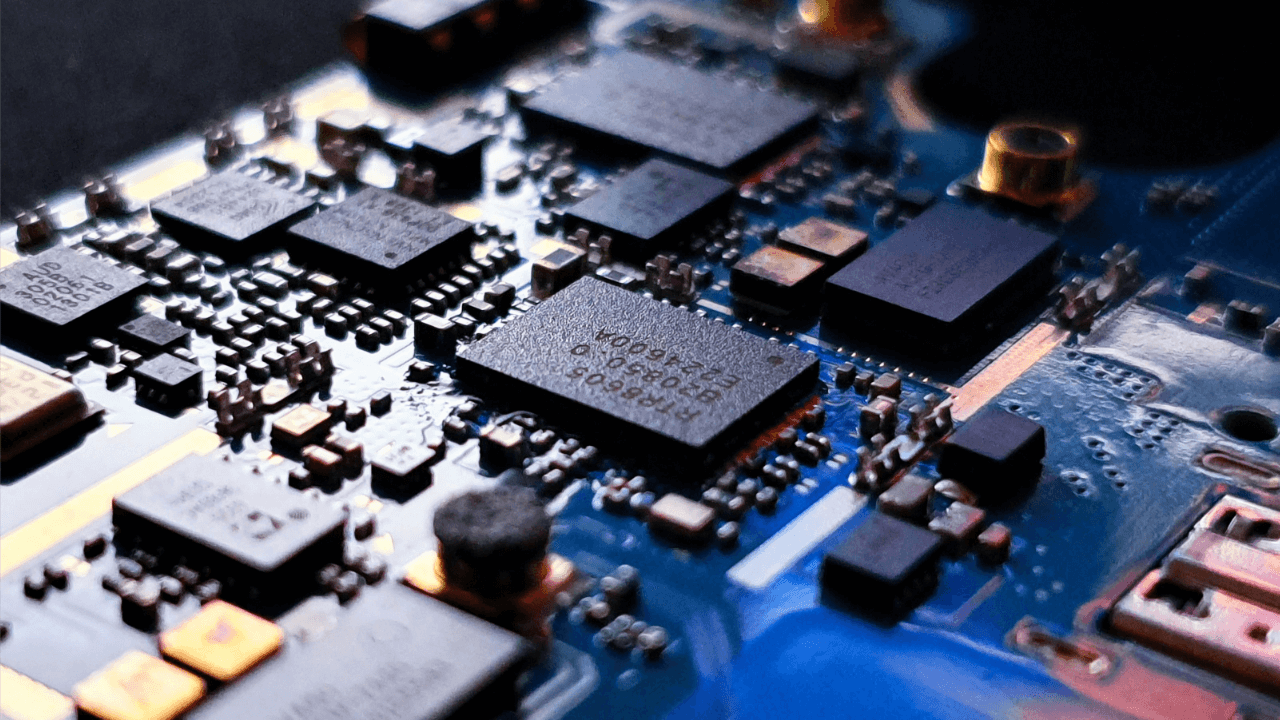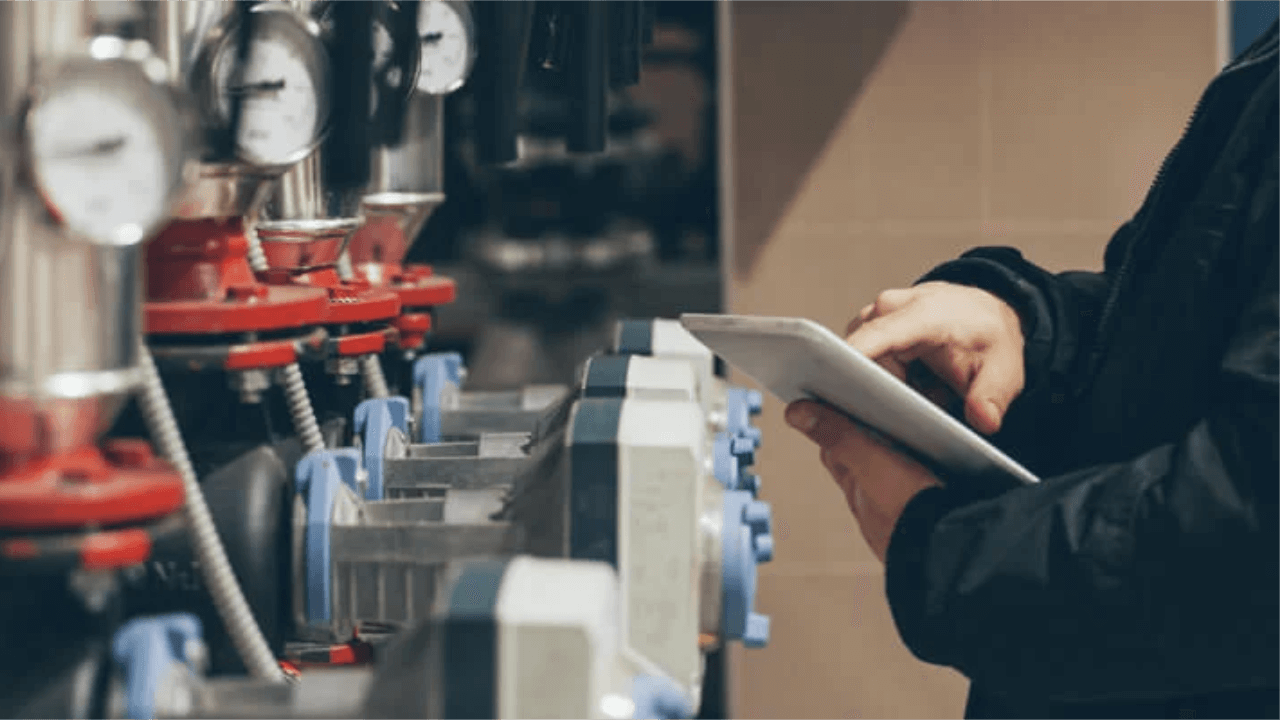
Machines are at the core of modern industry, performing crucial tasks for businesses. Maintaining this equipment is necessary to keep operations running smoothly and avoid costly downtime. To this end, many companies are turning toward proactive maintenance — this practice involves using intelligence and technology solutions to identify the optimal time to perform maintenance. One such solution is condition monitoring and its subsets, including vibration monitoring systems.
What Is a Condition Monitoring System?
Condition monitoring is a relatively new maintenance approach that utilizes technology to monitor the condition of machinery continuously. The approach relies on sensors, which collect precise data regarding a machine’s functionality. These sensors are connected by Internet of Things (IoT) systems, transmitting data to a machine monitoring software. The software collects, stores and organizes data, comparing it to given parameters. When machinery performance data falls outside acceptable ranges, the software will alert users to the discrepancy so they can respond quickly.
Using condition monitoring systems, businesses can detect potential failures early. This ability allows facilities to target their maintenance and repair operations for maximum effect. It also allows companies of all types to avoid costly equipment damage and downtime.
The utility of condition monitoring systems has led to its massive market growth — current projections expect annual growth of 7.1% over the next few years, leading to a market value of $3.6 billion by 2026.
Most businesses use condition monitoring to observe fragile and damage-prone components that tend to wear down faster. These include rotating parts, pumps and combustion equipment. Different types of condition monitoring solutions may be used depending on the type of equipment, such as vibration and temperature monitoring systems.
How Does Vibration Monitoring Work?
One type of condition monitoring system is vibration monitoring. This type of system uses vibration sensors to track equipment performance and lend insights into the condition of machinery. IoT systems use wireless vibration monitoring devices to collect data and wirelessly relay it to a machine monitoring software for storage and analysis.
Vibration monitoring systems are typically applied to heavy equipment, especially machinery that consists of rotating parts. Once applied, they track three key metrics:
- Low Frequency Vibration: The core intended vibration frequency defined by the motor rotational speed and harmonics (multiples) of the core frequency.
- High Frequency Vibration: Typically audible level squeaks and squeals from progressive bearing failures.
- Amplitude Progressions: What is the level of vibration at each frequency and how is it progressing over time?
- Temperature: Is the surface of the motor or bearing housing heating up and progressively getting hotter over time?
These vibration metrics are continuously logged in machine monitoring software. Upon collection, the software compares the data to baseline readings and preset parameters. If the readings fall outside these ranges, the system will flag them or send out an alert. Technicians can then use this data to identify patterns and predict the root cause of the problem. From there, technicians can plan and perform all necessary maintenance functions to resolve the issue.
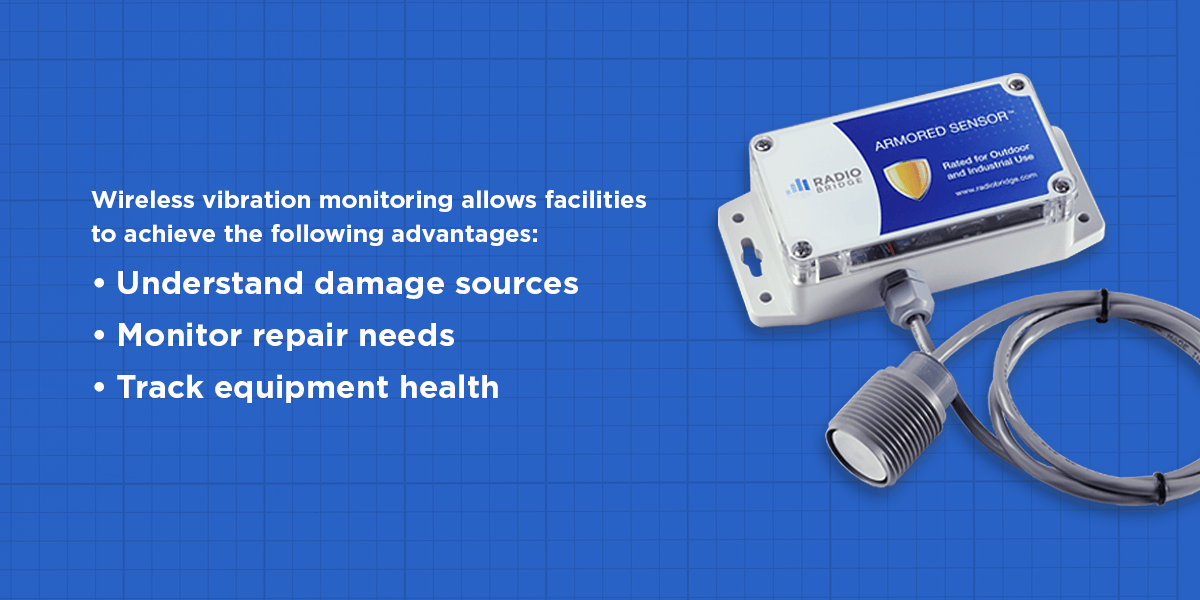
The Importance of Monitoring Vibrations
Monitoring vibrations can be a highly beneficial tool for any business using heavy equipment. Wireless vibration monitoring allows facilities to achieve the following advantages:
- Understand damage sources: Different machine failures will result in different vibration patterns. As a result, patterns in vibration data can be used in root cause analysis (RCA) to identify the source of the problem. Through continuous data collection, monitoring vibrations can help identify these patterns, allowing technicians to identify sources of damage so they can perform appropriate maintenance and repair functions more quickly.
- Monitor repair needs: Vibration monitoring can also help with predicting maintenance needs. IoT systems use wireless vibration monitoring to track vibration data in real time, identifying abnormal patterns as soon as they occur. This observation allows technicians to identify and perform repair and maintenance functions before failures happen, preventing costly downtime.
- Track equipment health: Vibration monitoring data can also be a valuable tool for tracking equipment health and adjusting usage. Vibration sensors can track data from assets during specific periods, identifying how they perform in given working conditions. This identification can be beneficial when adapting equipment to new processes or workloads. Vibration data can determine how well a piece of equipment is handling new conditions and whether those conditions should be changed to improve machine and process efficiency.
In total, these benefits help minimize downtime as machinery will be maintained and repaired when necessary rather than working until breaking down. You’ll also maximize job site safety with well-functioning equipment, improve efficiency and save money.
Failures IoT Vibration Monitoring Solutions Detect
Vibration monitoring solutions can identify a range of machinery failures. Some of the most common issues vibration monitoring can detect are detailed below.
1. Bearing Faults
Bearings are common features of rotating equipment and must be fitted and designed perfectly for machinery to function properly. While bearings are essential components, this also means bearing faults are a common source of failure. Unless caught in the early stages, bearing defects can rapidly lead to machinery malfunctions. Potential bearing defects include the following:
- Lubrication: Improper lubrication is one of the leading causes of bearing failure. Under-lubrication, over-lubrication and lubrication contamination can all result in bearing faults.
- Design: Improper bearing design is another common cause of failure. Small design defects can result in rapid-onset fatigue, leading to equipment damage.
- Mounting and alignment: Improper bearing mounting or alignment can also result in failure, placing excess stress on improper areas.
- Fatigue and wear: Fatigue and wear can also contribute to bearing faults over time. Wear such as pitting can result in vibration each time surfaces come into contact and can contribute to further wear over time.
Bearing faults are difficult to identify. Often, bearing failures aren’t caught or understood until after a machine has failed or sustained costly damage. Fortunately, vibration monitoring and analysis has proven to be a valuable tool for identifying bearing faults. Changes in vibration patterns for parts that use bearings can indicate potential bearing failures early, allowing technicians to step in and perform repairs before equipment sustains critical damage.
2. Lubrication Problems
Proper lubrication is another core requirement for a range of machinery types. As mentioned previously, bearings must be properly lubricated to function properly, and the same principle applies to a range of moving machinery parts. Some of the most common lubrication problems include:
- Lubricant starvation: Lubricant starvation is a common occurrence in machinery, with about 81% of lubrication professionals observing instances in their workplace. Insufficient lubrication can result in several machinery problems, including increased friction and heat. These factors can cause significant damage to machinery over time.
- Overgreasing: While parts need lubrication to facilitate movement, over-lubrication can present just as much of a problem as under-lubrication. Excess lubrication can result in energy loss and increased operating temperatures, which can contribute to increased equipment wear and fatigue. All of these factors can result in equipment failures over time.
- Contamination: Lubricant contamination is another common problem, often resulting from dirt and debris getting into the lubricant. If the contaminating particles are large enough, they can cause surface abrasions that pit and score parts, causing fatigue and damage over time.
Lubrication problems will often result in vibration. With vibration monitoring, these patterns can quickly be identified and tracked to the source parts, allowing technicians to remedy the problem quickly and avoid further damage.
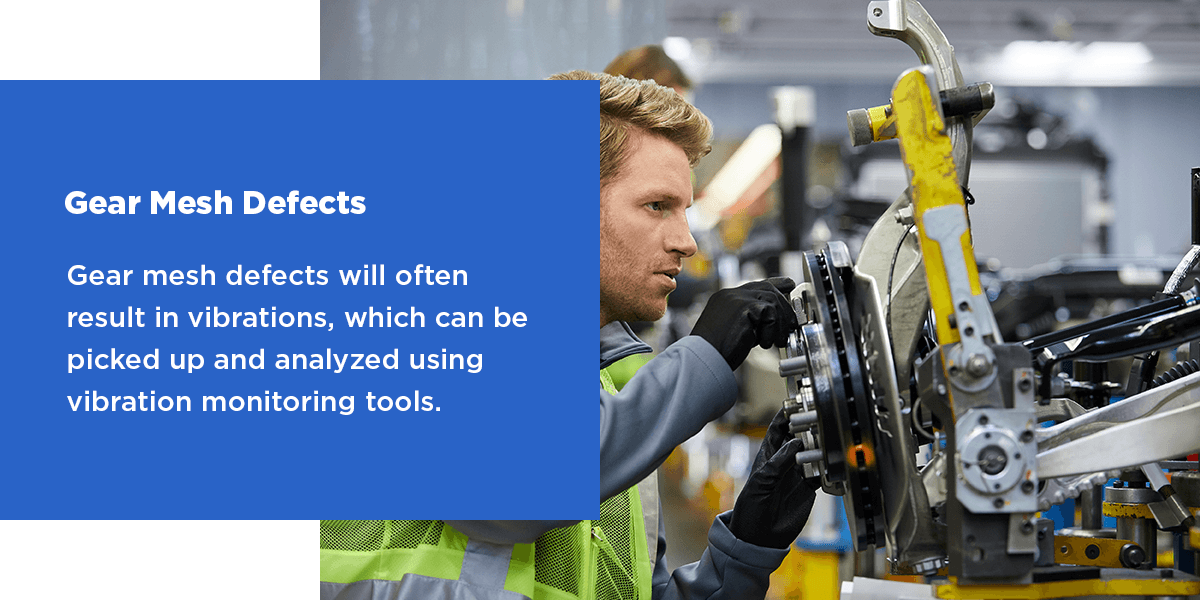
3. Gear Mesh Defects
Gear mesh, or the contact between gears as they rotate in machinery, must align and flow smoothly for machinery to function properly. Gear mesh defects can result in inefficient function, increased stress and noise and contribute to machine damage over time. Most gear defects are misalignments, which are typically the result of positional shifts or manufacturing errors. These misalignments fall into two categories:
- Parallel misalignments: In a parallel misalignment, the gears are parallel to one another but are slightly offset so they do not make full contact.
- Angular misalignments: In an angular misalignment, the gears come in contact at an angle that is not parallel.
Gear mesh defects will often result in vibrations, which can be picked up and analyzed using vibration monitoring tools.
4. Misalignment
Misalignments affect much more than gear meshes in machinery. Misaligned shafts, motors and pumps are other examples of misalignments that can occur.
Misalignments of machine parts can develop over time as a result of improper assembly, maintenance errors, component shifting, thermal expansion and uneven wear. Misaligned machine shafts of any type can result in undue stress over time, contributing to wear and fatigue. As with gear mesh misalignments, these misalignments fall into either parallel or angular misalignment categories.
Fortunately, as with gear mesh defects, misalignments often result in vibration. As a result, vibration monitoring solutions can identify these types of problems so technicians can perform necessary maintenance before a critical failure occurs.
5. Imbalances
Imbalances are another common problem in rotating equipment. Unbalanced equipment is defined as a rotating part with one portion that is slightly heavier than the rest. This imbalance is often the result of manufacturing defects, deformations or maintenance errors. Regardless of the source, part imbalances can cause damage.
When a rotating part is off-balance, this creates a centrifugal force as that heavy point rotates around the axis. That force places stress on the axis, especially at higher rotational speeds. Over time, this operation can result in serious damage and reduced part life.
While imbalances cause damage, they also create vibration. Vibrations contribute to reduced part life, but they can also be identified using vibration monitoring solutions.
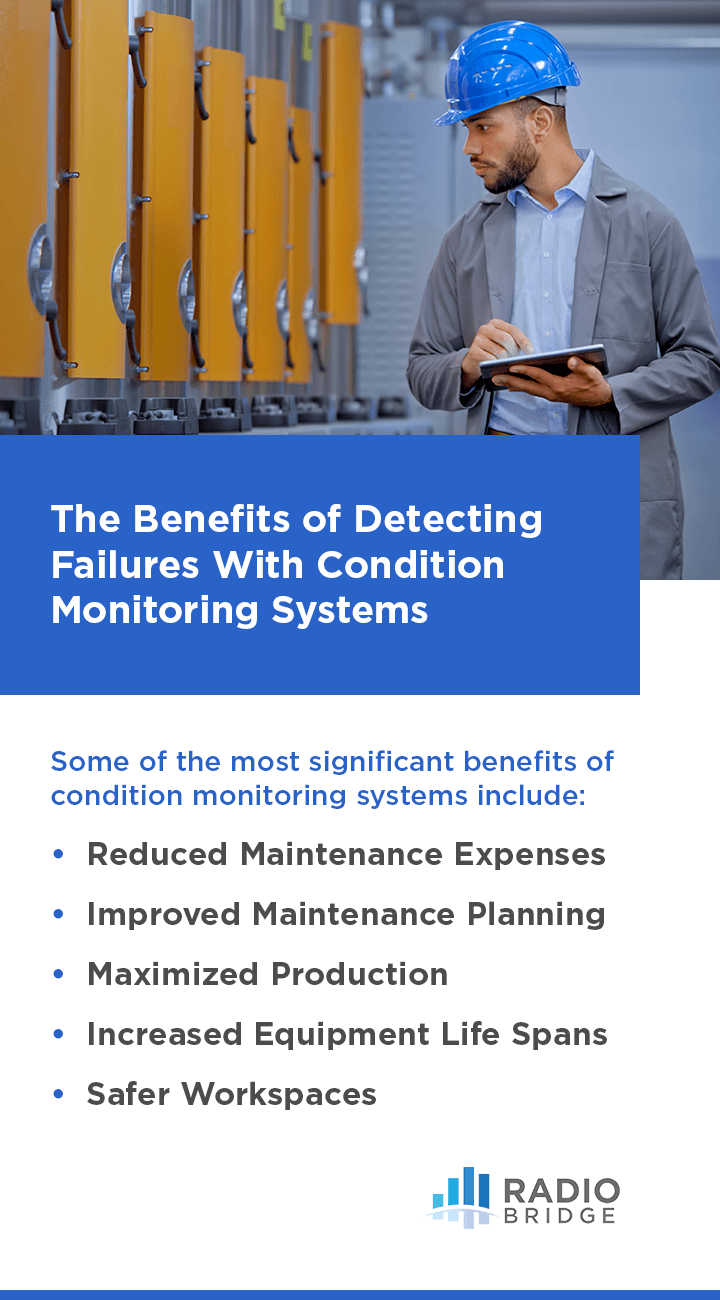
The Benefits of Detecting Failures With Condition Monitoring Systems
Whether you’re using a wireless vibration monitoring system or another type of condition monitoring system, this type of maintenance technology presents significant benefits to businesses. Some of the most significant benefits of condition monitoring systems include:
Reduced Maintenance Expenses
Equipment repair and maintenance functions are expensive — between hiring technicians and paying for tools and replacement parts, the costs are significant. That’s not to mention the cost of the labor involved to identify the source of a problem. With condition monitoring systems, you can reduce all of those costs. Condition monitoring helps identify problems before they become critical failures, reducing the expense of replacement parts.
Monitoring also helps quickly identify the source of a problem so your technicians are spending less time finding the problem and focusing more on the process of fixing it. Additionally, condition monitoring helps with predictive maintenance so your teams can plan maintenance efforts more effectively and efficiently, reducing wasteful spending on unnecessary maintenance.
Improved Maintenance Planning
Condition monitoring assists with predictive maintenance, which helps improve planning for maintenance functions. By offering predictions as to when equipment needs to be serviced, condition monitoring empowers maintenance staff to synchronize schedules, order parts and plan for downtime. This planning helps maximize the efficiency of maintenance operations while minimizing the effect on overall productivity.
Maximized Production
Damaged machinery is less efficient, and downtime kills productivity. Condition monitoring targets both of these concerns. Condition monitoring helps identify machinery problems early, allowing your company to ensure machinery is functioning at peak capacity. Monitoring solutions also help prevent critical failures, helping to avoid downtime. Both of these factors help ensure your company is operating at peak production.
Increased Equipment Life Spans
By pinpointing the source of a problem, condition monitoring can also help increase equipment life spans. Too often, companies replace equipment when the source of the problem is easily fixable, just hard to find. Condition monitoring allows technicians to find these problems quickly, saving money by repairing the equipment instead of replacing it.
Safer Workspaces
Damaged and malfunctioning equipment presents a safety hazard to workers around them and can also present a danger to technicians performing maintenance. With condition monitoring, critical failures can be caught early, and maintenance technicians can be aware of potential dangers so they can implement safety precautions.
Choose Radio Bridge, A MultiTech Brand, for Monitoring Solutions
Vibration analysis and condition monitoring solutions enable facilities to detect early signs of wear in equipment, allowing for more intelligent and proactive maintenance that creates a more cost-effective and safer working environment. If you’re looking for wireless vibration monitoring solutions to help develop your facility’s predictive maintenance capabilities, Radio Bridge has solutions.
Radio Bridge is among the leading Long Range Wide Area Network (LoRaWAN®) sensor manufacturers worldwide, providing predictive maintenance solutions for heavy equipment across practically any industry. Our solutions include a comprehensive vibration monitoring system that leverages advanced data collection and analysis to deliver actionable insights for your facility. Our sensors collect data around the clock and send it to on-site LoRaWAN gateways. These gateways then deliver data to the cloud-based Radio Bridge Console, where you can view your data and utilize advanced data analysis for predictive condition monitoring.
You can trust Radio Bridge products to deliver the maintenance analytics you need. Contact us today to learn more about our solutions or email us at info@radiobridge.com.



